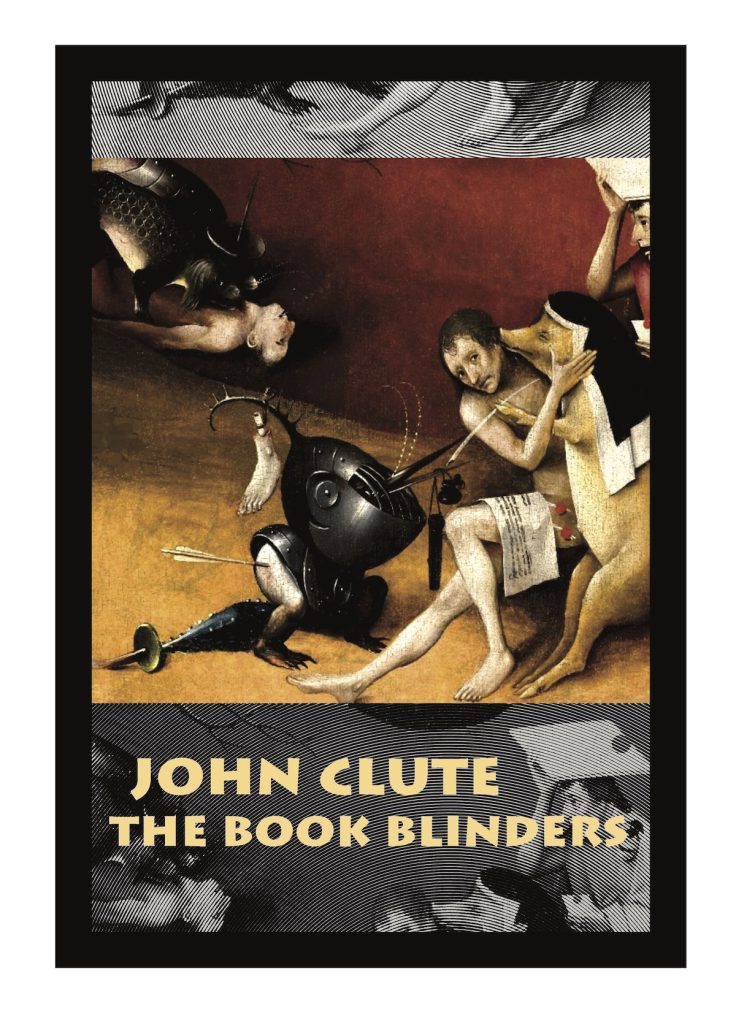— John Clute. The Book Blinders. Annals of Vandalism at the British Library: A Necrology. Illustrated throughout.
Norstrilia Press, [forthcoming 2024]. [Seen in proof state].
There has been a steady production of scholarship on the history of the publisher’s dust jacket in the past fifty years. These ephemeral pieces of paper encode all manner of information about the moment in time and both how publishers perceived their wares and how they wanted the reading and book-buying public to receive the newly published books. Much emphasis has been on nineteenth-century jackets in recent research, including in G. Thomas Tanselle’s Book-Jackets: Their History, Forms, and Use (2011), which updates work he first published in 1971, and Mark Godburn’s Nineteenth-Century Dust-Jackets (2016). And yet it is really in the early twentieth century that jackets proliferate and assume the form and function we now understand. Vast conceptual leaps in design and presentation of information occur between The Wind in the Willow (1908) to What Not (1918/1919) to In Our Time or The Great Gatsby (both 1925). And yet this is not solely the province of literary high spots. Across all types of literature, the dust jacket functions as the outer face of the book. The title, The Book Blinders, is descriptive of the practical effect for the reader of a long-standing institutional policy of discarding dust jackets or separating the jacket from the book and storing them elsewhere, uncatalogued. This policy prevailed at the British Museum (later British Library) and at other depository libraries from the emergence of the dust jacket and continued for most of the twentieth century. With more than 100 examples of dust jackets not in BL (from the years of the first world war through 1990), John Clute documents the importance of the dust jacket and considers the implications of this vandalism from within. How about these three or four: Rose Macaulay, What Not (1918), a tale of eugenics and privilege, suppression of a libellous passage delaying actual publication until 1919 (Clute’s copy is Michael Sadleir’s own, saved from the memory hole); C. E. M. Joad, Priscilla and Charybdis (1924), “undeterred by the gruelling wordplay of the title, [I] took a look, and found found this this on pages 206-207; a seductive Joad-like protagonist is addressing a young woman on a train ride they are sharing: ‘Darling [he purrs], have you ever travelled without a ticket?’ (this one alone is worth the price of admission); or Ezra Pound, Make It New (1934):
Faber (which is to say Eliot) clearly thought it sagacious to wrap in sheep’s clothing the already notorious Ezra Pound’s new publication with its incendiary title: a ticking bomb that needed no bush. But the underlying message cannot be missed: Pound’s title, a modernist wake-up slogan he’d been using offhandedly since 1928, is manifestly inflammatory, once grasped; a challenge to his various enemies who (he maintains) clog the literature pews: an up-yours bombination clearly audible through the enfant-sauvage mask Pound wore until it was too late. This bomb needed to slip through the gates before exploding.
or Robert Graves, The White Goddess (1948), Tom Eliot again; or Lawrence Leonard, The Horn of Mortal Danger (1980); or London Tales (1983), edited by Julian Evans. Clute’s selections are fascinating testimony to the breadth of his reading and collecting and his critical range; the text sparkles with his crunchy and apt vocabulary. It seems almost a homoeopathic distillation: “I’d reckon that out of every 8,000 or so books to arrive at the British Library complete with dust-jacket, I’ve commented here on a maximum of one”. (Excessive candor moment: John Clute is a friend of more than twenty-five years; I am the source for the images of the only jacket not from his own collection.) This is an important book.

